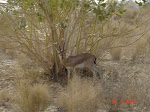Whenever one tries to visualize image of thar desert- there emerges picture of sand dunes, a man with turban and big mustache walking with a camel, a women carrying a pot of water on her head etc. In a way these symbols reflects life of this place. Camels- the most convenient way to commute in the dunes are rightly referred to as the ship of the desert. Scarcity of drinking water is a major challenge and the burden of fetching it lies on the shoulders of women and girl children. There are villages where women have to walk for 5-7 kilometers to fetch potable water. The situation worsens during drought.
When one walks across villages in Barmer, there are places where the government (PHED) water tanks are visible. In government records also a number of villages are categorized under ‘connected with water supply’ category. But it would be misleading to go by these figures. This is because villages here are spread over 5-15 kilometers and people live in dhanis- scattered hamlets. This makes water supply limited to the ‘village headquarter’. There is no doubt that it is equally challenging for government authorities too to make water available to every household/ village
Harvesting rain water for drinking purposes has been the traditional way people have used for serving their water needs. There are various forms of water harvesting structures c
 ommon throughout the western Rajasthan. Some caters to a group of families, some are individual and some are meant to serve the entire village community. The most common form of the water harvesting structure is the tanka. Tanka is a concrete underground water tank with a catchments area. In several places there are kuchcha tankas also-meaning underground wells without proper concrete and cover. Tanka generally caters to drinking needs of one family and is used both for harvesting and storing rain water. The most common size of a tanka is 10-12 feet deep with a diameter of 10 feet. In the desert economy it is considered as an asset of a family.
ommon throughout the western Rajasthan. Some caters to a group of families, some are individual and some are meant to serve the entire village community. The most common form of the water harvesting structure is the tanka. Tanka is a concrete underground water tank with a catchments area. In several places there are kuchcha tankas also-meaning underground wells without proper concrete and cover. Tanka generally caters to drinking needs of one family and is used both for harvesting and storing rain water. The most common size of a tanka is 10-12 feet deep with a diameter of 10 feet. In the desert economy it is considered as an asset of a family.During my stay here over all these years I have realized that tankas do not merely help in harvesting and storing water. They have a larger impact on the overall quality of life of the people. The structure gets full in two-three good rainfall and once filled it can cater to drinking needs of a average family for 6-8 months. If we calculate the monetary benefit, the amount which would have otherwise been spent on procuring same volume of water would have been somewhere around 2000-3000 rupees. So indirectly money saved is money earned by these rural household. Secondly, there is problem of excess fluoride content in the ground water. Rain water is free from any such contamination and is comparatively healthier. These are the immediate benefit one sees from tankas. The more vital impacts are on the quality of life of people. As the burden of fetching water is on the shoulders of women and girl children, the time saved not only reduces the drudgery but also positively impacts their life. It has been observed that the drop out rates of girl children is less in areas where access to drinking water if easier then those where one has to fetch water from far sources. The time saved by wo
 men are utilized in other productive purposes- more time for children and some taking up alternative employment like handicrafts etc (unfortunately, no additional time for rest!). It is not uncommon to see women even in their 7th-8th month of pregnancy queuing up near a water source. The availability of water harvesting structure near their home definitely reduces the ordeal.
men are utilized in other productive purposes- more time for children and some taking up alternative employment like handicrafts etc (unfortunately, no additional time for rest!). It is not uncommon to see women even in their 7th-8th month of pregnancy queuing up near a water source. The availability of water harvesting structure near their home definitely reduces the ordeal.Tankas are generally located near the dhani of a family. There is a smaller version of tankas known as tanklis. These are more of a water storing structures and are made within the household or just outside the house fence.
It is interesting that people in rural area don’t pay much attention to lock their houses but one would hardly find any tanka unlocked.
पानी है अनमोल ..... क्योंकि .....बिन पानी सब सून……


No comments:
Post a Comment